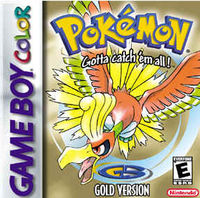Difference between revisions of "Pokémon: Gold and Silver Versions"
| Line 51: | Line 51: | ||
In 2001 a third version, ''[[Pokémon: Crystal Version]]'' was released. The game featured a subplot about [[Suicune]] and a man named Eusine who wished to catch it. It also added the Battle Tower, which featured ''[[Pokémon Stadium]]'' style battles, and the option to choose to play as a girl. | In 2001 a third version, ''[[Pokémon: Crystal Version]]'' was released. The game featured a subplot about [[Suicune]] and a man named Eusine who wished to catch it. It also added the Battle Tower, which featured ''[[Pokémon Stadium]]'' style battles, and the option to choose to play as a girl. | ||
| + | |||
| + | Is is being remade for the [[Nintendo DS]] as ''[[Pokémon: HeartGold and SoulSilver Versions]]''. | ||
[[Category: Video Games]] [[Category: Gameboy Color Games]] [[Category: Pokémon Games]] [[Category: Player's Choice]] | [[Category: Video Games]] [[Category: Gameboy Color Games]] [[Category: Pokémon Games]] [[Category: Player's Choice]] | ||
Revision as of 17:41, 13 May 2009

| |
| Pokémon: Gold/Silver Versions | |
| Developer | Game Freak |
| Publisher | Nintendo |
| System | Gameboy Color |
| Release Date | JP: November 21, 1999 US: October 15, 2000 AU: October 16, 2000 EU: April 16, 2001 |
| Rating | ESRB: E |
Pokémon: Gold Version and Pokémon: Silver Version are the second set of games in the Pokémon series. The different versions were made to increase interactivity between gamers (as gamers would have to trade Pokémon with each other in order to collect all of the game's monsters).
Story
Taking place after the events of the original set of games, Pokémon Gold and Silver follow the journey of a new character, Gold (Gold is the default; the player may name him anything). Like Red, Gold wants to become a Pokémon master. To accomplish this, Gold must defeat eight Pokémon gym leaders; defeat the Elite Four; compete with his rival, Silver; foil the plans of Team Rocket; and capture as many of the different species of Pokémon as he can.
Gameplay
Pokémon Gold and Silver retains much of the gameplay of the original set of games. However, they have added some things. The most notable addition is the 100 new species of Pokémon the game introduced.
Probably the thing that effected was the games internal clock. Using the internal clock, they could make certain things happen depending on the time of day or the day of the week. For example, the owl Pokémon Hoothoot might only appear at night. Another example is some people only appear on Monday.
Another change to the game was Pokémon breeding. If the player left two compatible Pokémon at the Pokémon Daycare for an hour, an egg would be there when they returned. The egg would hatch into a new Pokémon.
Connectivity
Using the Gameboy Link Cable, games could be connected so that the Pokémon could be traded or used in battle. Some Pokémon could only be obtained through trade- not only Pokémon that were exclusive to one version but also Pokémon that could only evolve after being traded. There were also several points in the game were the player had to choose one out of two or more Pokémon to own (such as in the beginning, where the trainer must choose between a Cyndaquil, Totodile or Chikorita), and the Pokémon not chosen could then only be obtained by trading with another player. Pokémon could also be transferred into the games through Nintendo representatives; this was the only method of acquiring Serebii, the hidden 251st Pokémon, without use of glitches or cheating devices.
Gold and Silver could also be linked with the original games for trade; however, the Gold and Silver players could not trade any of the new Pokémon introduced in those games, nor could they trade Pokémon that knew one of the new moves introduced in Gold and Silver. Finally, these games could be linked to the Pokémon Stadium 2 games on the Nintendo 64, where the Pokémon could be used in 3-D battles, and several unique Pokémon with special moves could be unlocked.
In addition to trading Pokémon, Gold and Silver added a new feature called Mystery Gift. Two players would receive a random item or decoration by using the IR port on the top of their Gameboy Color.
Version Differences
In all regions, Pokémon Gold and Silver released simultaneously. In order to increase player interactivity, each version had certain Pokémon the other didn't. In addition, there were certain Pokémon that could only be found in Pokémon Red, Pokémon Blue, or Pokémon Yellow.
Legacy
These games has inspired a new set off spin-offs.
Pokémon from Gold and Silver have also appeared in Super Smash Bros. Melee. Most notably, Pichu is a playable character.
Sequels
These games were followed up by the third generation games, Pokémon: Ruby and Sapphire Versions.
Remakes/Rereleases
In 2001 a third version, Pokémon: Crystal Version was released. The game featured a subplot about Suicune and a man named Eusine who wished to catch it. It also added the Battle Tower, which featured Pokémon Stadium style battles, and the option to choose to play as a girl.
Is is being remade for the Nintendo DS as Pokémon: HeartGold and SoulSilver Versions.